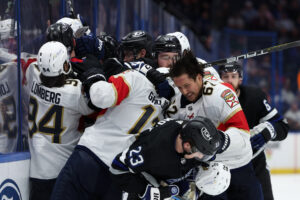There’s a lot we don’t know yet about the upcoming NHL season, including when it will start. But some things are going to be a given, like the Canadian teams carrying larger rosters than normal. Whether those players include a separate, isolated group is a question we’re going to look at now. Specifically: what difficulties and benefits might come from a Vancouver Canucks taxi squad?
Vancouver Canucks Roster and Taxi Squad Issues
What About the Money?
Okay, first off what we’re not going to look at here is the financial juggling involved. Letting three Canadian NHL teams carry larger rosters without penalty seems unlikely, given the other 28 teams. But making just three teams wait two weeks for backup players in the event of injury is equally unequal. It seems the most likely answer is going to be allowing the team to carry the players, but at their AHL salaries and off the cap. There is talk of those players getting an NHL-level per diem, but for our purposes, that’s neither here nor there. Right now, we’re talking who’s here and who counts.
Bigger Roster, Taxi Squad, or Both?
Right now, the assumption is both. Have to start somewhere!
The increased roster size, if one happens, will probably be applied to the league as a whole. Travel doesn’t just involve crossing borders, after all, and movement does increase risk. Likewise, any temporary increase in team size should be applied equally, and it’s not an unreasonable thing to do. The current maximum a team can carry on their opening night roster is 23, though some could start with fewer to meet with salary cap restrictions. The Canucks, for instance, might “paper down” Quinn Hughes and Jack Rathbone to the AHL to get below the cap. They are waiver-ineligible so can’t get selected and it gives the team $1.84 million in cap room. After opening night, the Canucks will call them up after putting Micheal Ferland on injured reserve.
Should that roster list increase to, say, 26 players instead of 23, then the cap will have to accommodate that. Or a team could select a “cap-invisible” player for this season or some other kind of magic bullet. Whatever they choose it’ll just be for the one year. A more interesting question is how teams will stock not just the extra players, but an additional taxi squad.
Roger, Roster
Everyone’s familiar with “that guy” on their team. The Thirteenth Forward or the Seventh Defenceman. Hard worker, practices his guts out, good in the room, etc. Maybe they add a bit more size, grit, and… truculence. These are the players you see in the stats at the end of the year and realize they were only in 17 games. Or maybe one breaks through and actually takes a regular’s place by season’s end (cough Oscar Fantenberg cough).
The key here is that those players whose job is to eat popcorn until an emergency are either veterans or, sometimes, “tweeners” who have a lower ceiling than a top-ten prospect. Fantenberg is an example of the former, and Zack MacEwen is one of the latter. Even without a border to get through it takes time to get players from farm clubs to their parents. One team or the other might be on the road, or connections might not be readily available. So teams carry a couple spare players in case of emergency. They generally practice with the regular players to keep them familiar with game plans for a minimum of disruption.
There are certainly players both in the Canucks system and as free agents who could fit this role easily enough. These are players a coach can trust to go into a game cold and do well enough until the guy they’re replacing returns. The spare tires of the NHL. But what if you need the entire car? Enter the Canucks taxi squad.
Lyft Us Up
The unique situation we’re in now requires a unique solution. Or rather the same unique solution we found last time. If a team member tests positive for COVID-19, what happens? Players aren’t going to be in bubbles like they were for the Stanley Cup Playoffs. Looking at other leagues already active, it seems most likely the league will try to continue play. That can work to sub in a new player and treat it as an injury. An injury with an isolation period, granted, but still. That’ll work until another three or four players test positive, which is where the taxi squad comes in.
A taxi squad will be players isolated from the rest of the team, and this brings its own problems. Instead of being an extra roster player, this is theoretically a “call up” from the minors. And who normally gets called up? Well, that often depends on the reason. Frequently a call up will happen because one of the spares is going to be playing for a couple of days. The new arrival joins the team as the new spare, going back when no longer needed. Except sometimes.
If the player injured is a skilled guy, the team may decide that it’s an inappropriate spot for their current spare. A high-ceiling prospect can be called up then with the assurance of getting substantial ice time. He won’t get tossed into a grinder’s role that just doesn’t fit him. Skill plays with skill. When he does go back to the minors, he resumes a major role there, too. Which is the problem. Because the Canucks taxi squad – or the Edmonton Oilers‘, or the Calgary Flames‘ – won’t be playing games anywhere. Skipping a month isn’t great; over a full season?
Going Zero-to-Six
Whatever format the NHL finally decides on, teams are going to have a decision to make. Players are needed for the press box, ready to join the team at the drop of a helmet. They aren’t going to get a lot of ice time – or possibly any. Putting prospects there won’t help their development anywhere near as much as a full-time role in the AHL. But an enlarged taxi squad – from which players can come in en masse – might not even get the opportunity to practice with the NHL club. They’ll get NHL coaching, of course, but no games.
This is because players won’t be in a full bubble, as they were in Edmonton. As such, their risk of catching the novel coronavirus are higher than they were during the Stanley Cup Playoffs. Should an infected player be discovered soon enough, they can be isolated without it spreading to teammates. But that he was with teammates puts them at risk. The best option, then, is to have a group already isolated from the team, reducing their risk. That “clean” player – or players – can join the team immediately. No waiting through two weeks of isolation, or even two consecutive days of negative tests.
The question is, who do the NHL teams put there? Should they pull veteran leaders off their minors team? Skilled players, who are closest to the NHL level? By all accounts, the Canadian division is going to be tight. They’ll want their best players, but can they justify keeping those players off the ice?
The only certainty right now is that the decisions aren’t going to get any easier between now and puck drop.
Main Photo:






